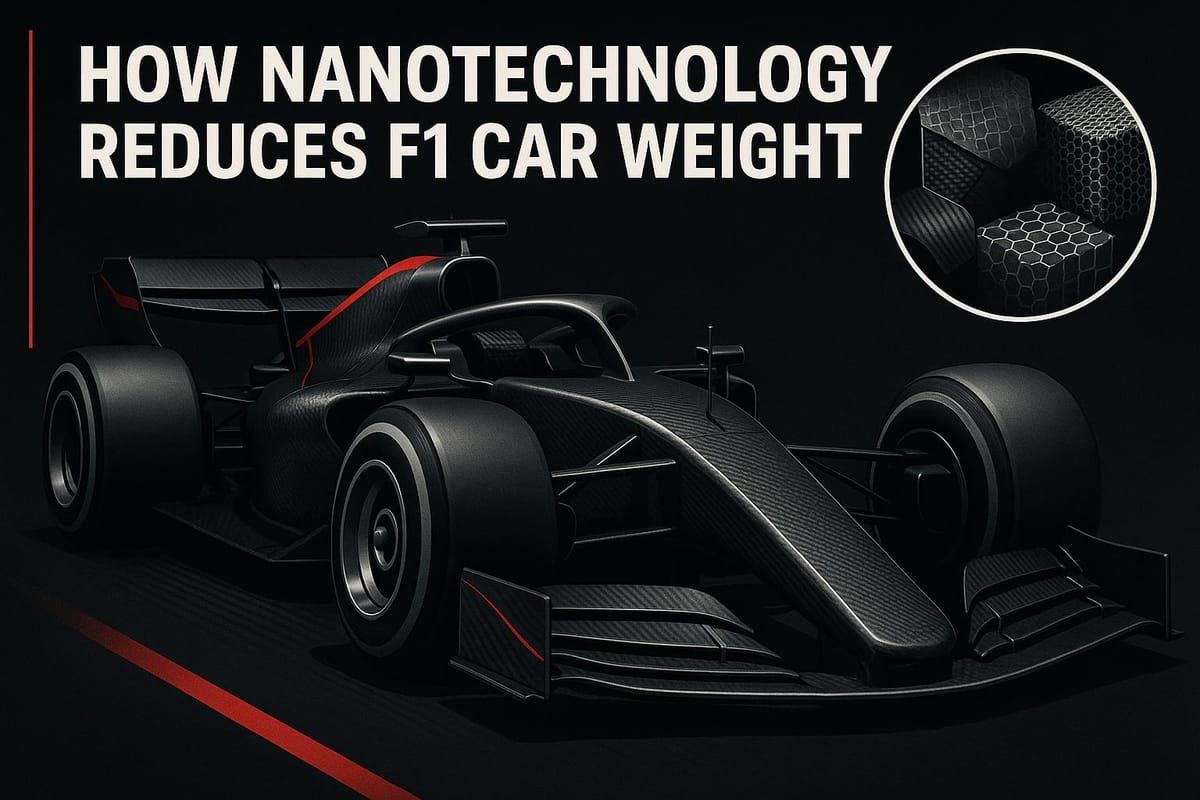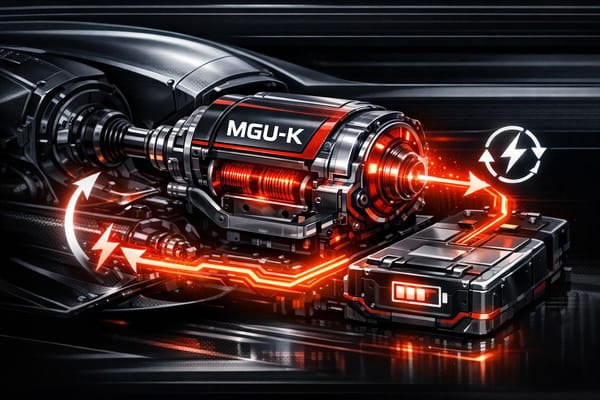How Nanotechnology Reduces F1 Car Weight
Explore how nanotechnology is transforming Formula 1 by reducing car weight and enhancing performance through innovative materials.

Nanotechnology is reshaping Formula 1 by creating lighter, stronger, and more efficient materials. By working at the molecular level, engineers enhance components like body panels, suspension systems, and heat exchangers for better performance without sacrificing safety. Key materials include carbon nanotubes, graphene, nano-enhanced resins, and ultra-thin coatings. These innovations reduce weight, improve heat resistance, and increase durability, giving teams a competitive edge. However, challenges like high costs, manufacturing complexities, and regulatory uncertainties remain. Despite this, nanotechnology is driving F1 toward faster, lighter, and more optimized cars.
Graphene Technology That Could Revolutionise F1
Key Nanomaterials Used in F1 Car Construction
Nanomaterials are revolutionizing the way F1 cars are built, especially when it comes to reducing weight. These materials operate at the molecular level, offering a mix of strength, lightness, and durability that traditional materials simply can't match. Let’s dive into how these cutting-edge advancements are shaping the components of F1 cars.
Carbon Nanotubes and Graphene
Carbon nanotubes are a game-changer for F1 engineering. These tiny cylindrical structures, made entirely of carbon atoms, are incredibly strong and lightweight. When used to reinforce carbon fiber composites, they enhance performance while keeping weight to a minimum.
Graphene, another marvel, consists of a single layer of carbon atoms arranged in a hexagonal pattern. It’s known for its exceptional strength, thinness, and ability to conduct heat. In F1 cars, graphene plays a critical role in heat management. By efficiently dissipating heat from components like brakes and electronic control units, graphene allows engineers to replace heavier materials with lighter, graphene-infused alternatives.
Nano-Enhanced Resins and Polymers
Nanotechnology has also improved the resin systems that bind carbon fiber composites. By adding nanoparticles to standard epoxy formulations, engineers have developed nano-enhanced resins that are stronger and more resistant to high temperatures. This allows for the use of less material without sacrificing structural integrity, making components like chassis panels and aerodynamic parts lighter and more efficient.
Nano-enhanced polymers bring these benefits to other areas, such as electronic housings and cable management systems. By dispersing nanoparticles evenly within these polymers, manufacturers produce lighter, tougher components that handle heat more effectively. Advances in precision manufacturing ensure these materials perform reliably under the intense conditions of F1 racing.
Nano-Coatings and Surface Treatments
Beyond strengthening materials, surface treatments play a key role in optimizing weight and durability. Ultra-thin nano-coatings are especially important, as they modify the properties of components without adding unnecessary weight.
In F1 construction, nano-coatings serve several purposes. Anti-friction coatings on moving parts reduce mechanical losses, cutting down the need for heavier lubricants. Thermal barrier coatings protect components exposed to extreme heat - like exhaust systems and brake parts - allowing engineers to use lighter base materials that wouldn’t normally withstand such conditions. Corrosion-resistant nano-coatings also shield lightweight alloys, eliminating the need for bulkier protective measures.
These nanomaterial advancements work together to create a more efficient and lightweight F1 car. By improving strength, heat resistance, and durability, these innovations ensure that every component performs at its best, all while keeping weight to an absolute minimum on the racetrack.
How Nanotechnology Reduces Weight
Nanotechnology works its magic at the molecular level, changing how materials behave to make them lighter without losing strength or durability. By enhancing Formula 1 materials with nanoscale innovations, engineers can create lighter components that still meet the high-performance demands of racing.
Improved Strength-to-Weight Ratios
When carbon nanotubes and graphene are added to composites, they form reinforcement structures that allow for thinner and lighter parts like chassis components, suspension arms, and aerodynamic features. Despite being lighter, these materials still meet the strict crash-test standards required in motorsports.
This technology is especially valuable for safety-critical parts. For example, the monocoque chassis, which must pass rigorous FIA crash tests, benefits from nano-enhanced materials. These materials absorb more energy per unit of weight, enabling engineers to use less material while maintaining - or even improving - safety.
Enhanced Thermal and Abrasion Resistance
Nanotechnology isn’t just about structural strength - it also improves thermal and wear resistance. Nano-enhanced materials can handle extreme temperatures, reducing the need for heavy heat shields. For example, brake components made with nano-enhanced carbon composites can endure high heat without requiring additional protective coatings.
Thermal management improvements go beyond the brakes. Electronic control units, for instance, can use nanopolymers that efficiently dissipate heat while keeping weight low. Suspension and steering systems also benefit from nano-coatings that resist abrasion without the added bulk of traditional protective layers or replaceable wear plates.
Lightweight Support Materials
Nanotechnology also shines in smaller components that collectively contribute to weight reduction. Take automotive paints, for example. Traditional paints require multiple layers for durability and color consistency, but nano-enhanced paints deliver the same quality with a much thinner application.
Nano-adhesives and bonding agents are another win. These materials create stronger bonds with less material, which is especially useful for areas where components are bonded instead of mechanically fastened, like aerodynamic parts and interior panels.
Even seemingly minor systems, such as cable management and wire harnesses, benefit from nano-enhanced plastics and composites. These materials provide necessary insulation and protection while being lighter than conventional options.
Together, these advancements in nanotechnology lead to significant weight savings across the car. And in the high-stakes world of racing, every ounce saved translates into a measurable performance edge on the track.
Case Studies: Nanotechnology Applications in Recent F1 Cars
The impact of nanotechnology on Formula 1 cars isn't just theoretical - it’s making a tangible difference on the track. A standout example is the use of ultra-lightweight paint formulations, which allow teams to reduce vehicle weight while staying within safety regulations.
Ultra-Lightweight Paints
Recent advancements in nano-enhanced paints have given Formula 1 teams a way to shave off critical pounds. These paints typically weigh between 3.3 and 13.2 lbs (1.5 to 6 kg) per car, significantly less than the 4.4 to 17.6 lbs (2 to 8 kg) seen in road cars, which cover larger surface areas.
Why does this matter? In Formula 1, every gram counts. A reduction of 22 lbs (10 kg) can improve lap times by roughly 0.3 seconds - a difference that can mean the gap between winning and losing. Teams achieve these weight savings by applying nano-enhanced paints in thinner layers, often using precision airbrushing techniques. Some even leave parts of the car’s natural carbon fiber exposed to minimize added weight.
Additionally, surface finish innovations have played a role. Matte finishes, which became popular after Red Bull introduced them in the mid-2010s and Ferrari followed suit in 2019, offer more than just a sleek appearance. They can save up to 1.3 lbs (600 grams) compared to gloss finishes. Beyond weight savings, matte finishes help repel rubber debris during races, ensuring smoother airflow over the car’s body for better aerodynamics.
Challenges, Limitations, and Future Directions
Nanotechnology is revolutionizing F1 car design by significantly reducing weight, but it comes with its own set of challenges, particularly in manufacturing, safety, and regulatory compliance.
High Costs and Manufacturing Complexities
Using nanotechnology in F1 requires a hefty financial commitment. Producing nanomaterials like carbon nanotube–enhanced components isn't straightforward - it demands specialized equipment, precise conditions, and high temperatures. Even a tiny bit of contamination can derail production, causing delays and wasting materials.
Scaling up from lab prototypes to full-season F1 components adds another layer of difficulty. What works flawlessly in a controlled lab setting often struggles when applied to large-scale production. Ensuring consistent quality at this level requires highly sensitive testing methods to catch even the smallest flaws.
Regulatory and Safety Considerations
The regulatory landscape for nanotechnology in F1 is still catching up with the pace of innovation. Current technical rules don’t fully address these advanced materials, leaving teams in a gray area. This uncertainty forces teams and governing bodies to work together to establish rigorous testing standards and detailed documentation to ensure safety for everyone involved - drivers, mechanics, and trackside personnel.
Traditional crash tests and material certifications aren’t designed to account for the unique properties of nanomaterials. This means that existing safety protocols often fall short, creating gaps that need to be addressed as the technology evolves.
New Trends and Future Developments
Despite these obstacles, progress in the field is promising. Teams are turning to cutting-edge solutions to tackle these challenges. For instance, additive manufacturing (3D printing) is emerging as a game-changer, offering a way to produce nano-enhanced components with heightened precision and efficiency. Artificial intelligence is also playing a role, helping researchers optimize material properties and speed up development cycles.
Exciting advancements like self-healing materials are being explored. These materials could repair minor damage on their own, improving durability and reducing the need for constant maintenance. There’s also growing interest in sustainable nanomaterials that align with environmental goals, aiming to strike a balance between peak performance and eco-conscious practices.
Looking ahead, innovations in nanomaterials could lead to better thermal management, allowing components to dissipate heat more efficiently. Even more futuristic are smart materials that might adapt their properties in real time to match changing track conditions - all while keeping the ultra-lightweight design that F1 demands.
Conclusion: Nanotechnology's Impact on F1's Future
Nanotechnology is reshaping Formula 1 by making cars lighter without sacrificing performance or safety. Think about carbon nanotubes - they offer incredible strength while keeping weight to a minimum. Then there are nano-enhanced coatings, which protect components at a microscopic level. These innovations are changing the sport, not just in theory but down to the molecular scale.
Right now, teams are already using this technology in creative ways. For example, ultra-lightweight paints and nano-reinforced battery enclosures are helping cars shed unnecessary weight. This allows teams to redistribute weight more effectively, all while meeting the strict structural standards set by the FIA. But while these advancements are impressive, the journey toward full-scale adoption isn’t without its challenges.
One major hurdle is cost. Manufacturing these advanced materials is expensive, and the complex production processes make it tough to implement them widely. On top of that, regulatory frameworks haven’t caught up with the speed of technological progress. As Brian Anthony from MIT.nano points out, integrating electrical, optical, and fluidic systems into single packages is no small feat. Another concern is the lack of specialized expertise in nanotechnology, which could slow future innovation.
Still, nanotechnology is redefining how F1 cars are designed. It’s rewriting the rulebook on how weight, strength, and performance interact, opening doors to engineering breakthroughs that once seemed out of reach. As production costs drop and regulations evolve, these materials are likely to become a crucial factor in determining which teams dominate the grid.
FAQs
How does nanotechnology help F1 cars become lighter and faster?
Nanotechnology has become a game-changer in Formula 1, helping cars become both lighter and faster. One standout innovation is carbon nanotubes (CNTs) - materials that are up to 100 times stronger than steel but only a fraction of the weight. This remarkable combination allows engineers to cut down on weight without compromising on strength or safety.
A lighter car isn’t just about speed; it’s about performance. Reduced weight leads to quicker acceleration, sharper cornering, and better fuel efficiency. On top of that, incorporating sustainable carbon fiber composites ensures that these cars remain durable enough to handle the intense demands of F1 racing, all while keeping weight to a minimum.
What challenges do F1 teams face when using nanotechnology to reduce car weight?
F1 teams face a host of challenges when trying to integrate nanotechnology into their car designs. A key concern is balancing safety and durability with the use of lightweight nanomaterials. These materials need to endure the extreme conditions of racing without losing their structural strength - no small feat in a sport where every component is pushed to its limits.
Another significant hurdle is the high cost associated with nanotechnology. On top of that, scaling up manufacturing processes to meet the demands of Formula One adds another layer of complexity. These financial and logistical barriers make widespread implementation tough.
Then there’s the issue of regulatory compliance. Navigating the rules and ensuring consistent quality control is essential in an environment where even the smallest oversight can have major consequences.
Still, the promise of nanotechnology - like boosting performance and improving fuel efficiency - continues to push teams to explore its potential, despite the challenges.
How could future advancements in nanotechnology transform the design and performance of F1 cars?
Future developments in nanotechnology have the potential to reshape F1 car design and performance. By incorporating materials like nanocomposites, teams could create ultra-lightweight yet incredibly strong components. This would allow cars to shed weight without compromising on durability or safety - an advantage that could make a real difference on race day.
Nanotechnology might also bring breakthroughs in aerodynamics and thermal management. With advanced coatings and surface treatments, teams could optimize airflow and improve heat dissipation. The result? Faster speeds, better fuel efficiency, and enhanced reliability - giving teams the tools to push performance to the next level.




